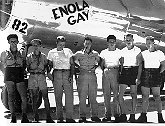

![]()

|
Atom Bomb.
Tom Seddon.
Grades 7 - 9 / Ages 12 - 15.
* * /4
|
excerpt:
At precisely 8:15:17 A.M. Hiroshima time, ``Little Boy" tumbled out of Enola Gay's bomb bay. Tibbets threw the plane into a steep diving turn, in order to escape. After 45 seconds the flash came. More than the momentary blinding light, Tibbets remembered feeling a distinct taste of lead on his tongue. Apparently, the radiation from the bomb's burst struck the fillings of his teeth and caused a chemical reaction . . .Already a giant purple-streaked mushroom cloud had risen 3 miles (5 kilometers) higher than the 6-mile (10-kilometers) altitude of the plane and was still boiling upward. Hiroshima had disappeared under a thick, churning foam of flames and smoke as a hurricane of fire ravaged the city. Shock and horror swept over the crew.
Co-pilot Richard Lewis exclaimed,``My God, what have we done?"
TOM SEDDON CALLS ATOM BOMB a ``picture album." The ``album" is meant to tell three stories: the great scientific quest to understand the puzzle of radioactivity, the Manhattan Project's effort to control and use the power of nuclear fission to win World War II, and the beginnings of anti-nuclear sentiments.

Unfortunately, like many picture albums, Seddon's is of interest only to the person who put it together. The ``album" has lots of uninspiring pictures of dead physicists. Henri Becquerel is wearing a uniform and a sword; Marie and Pierre Curie are standing by their bicycles; James Chadwick, Otto Frisch, and Neils Bohr are not doing much; but Enrico Fermi, Otto Hahn, and Fredric Joliot-Curie are doing some non-specific science stuff. Robert Oppenheimer looks bored, but in what is probably the best of the dead physicists' pictures, James Conant and Vannevar Bush look very drunk after the Trinity nuclear test.
The nuclear spy and physicist Klaus Fuchs, who gave the atomic secret to the Soviets, has two identical photos, except that one is a negative image (I suppose that's because we see through him now). Seddon uses this negative image juxtaposition far too often in his ``picture album." He even includes as part of a picture-in-picture view of the Knoxville, Tennessee research complex and the ``Little Boy" nuclear bomb. Once was enough; more is cheap theatrics!

Some of the images of the nuclear destruction of Hiroshima and Nagasaki are tragically evocative. But again Seddon uses theatrics for no real purpose. He turns what could have been edifying images into exploitative cant. And repeatedly using of negative images does little but cheapen and distort the tragic quality of the original pictures.
Seddon's short text does tell the stories he set out to tell, but much of the text is written in a lurid, staccato style that seems meant to titillate rather than educate. The poor attempts at melodramatic flourish do little for the reader.
Unfortunately, many librarians will buy this book based the publisher's description of its merits. They will be disappointed in thin poorly crafted ``picture album" cum book.
Not recommended
Ian Stewart works at Lord Nelson School in Winnipeg and at the University of Winnipeg library.
To comment on this title or this review, send mail to cmeditor@mts.net.
![]()
Copyright © 1996 the Manitoba Library Association.
Reproduction for personal use is permitted only if this copyright notice
is maintained. Any other reproduction is prohibited without permission.
Published by
The Manitoba Library Association
ISSN 1201-9364
![]()